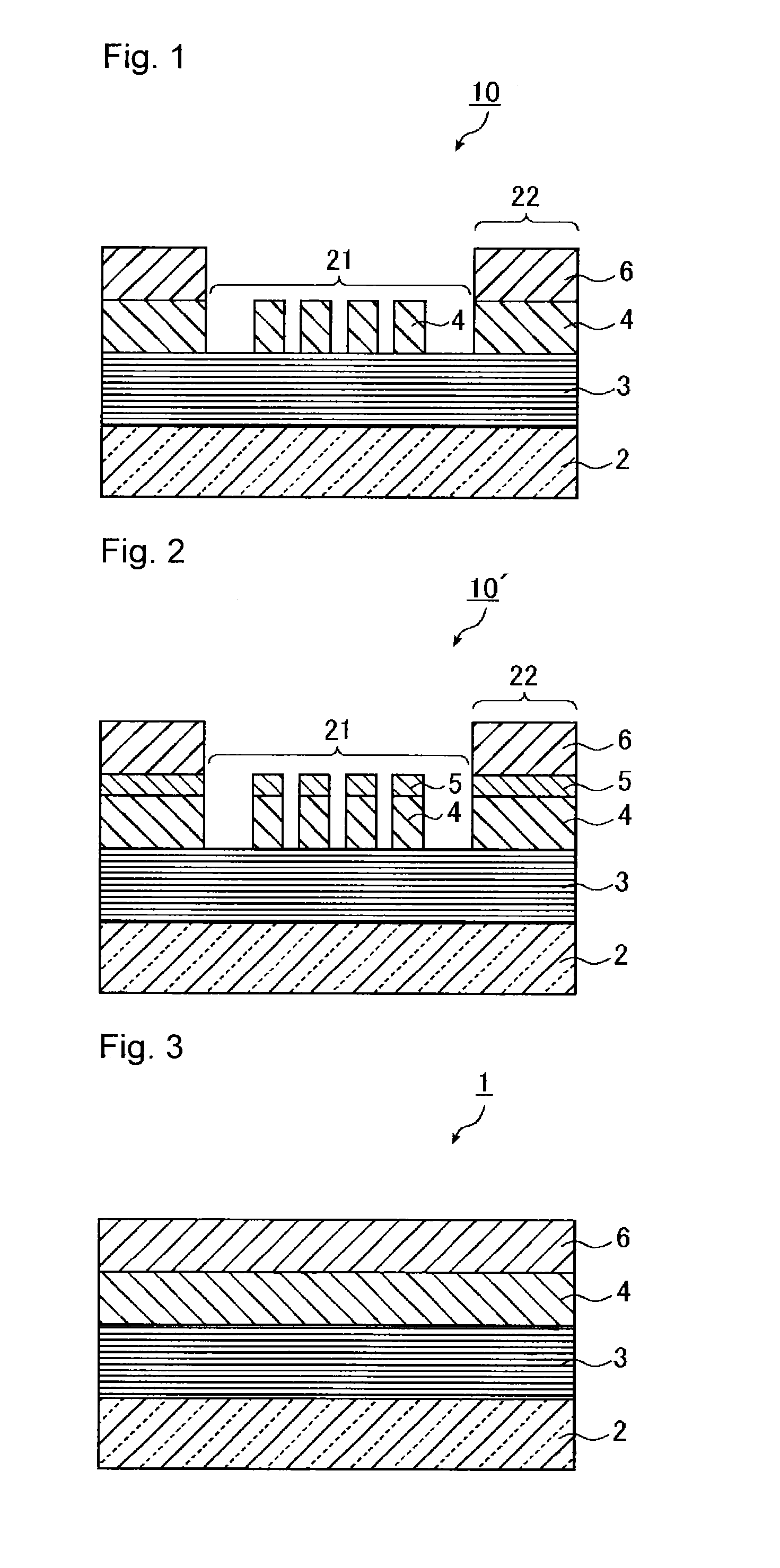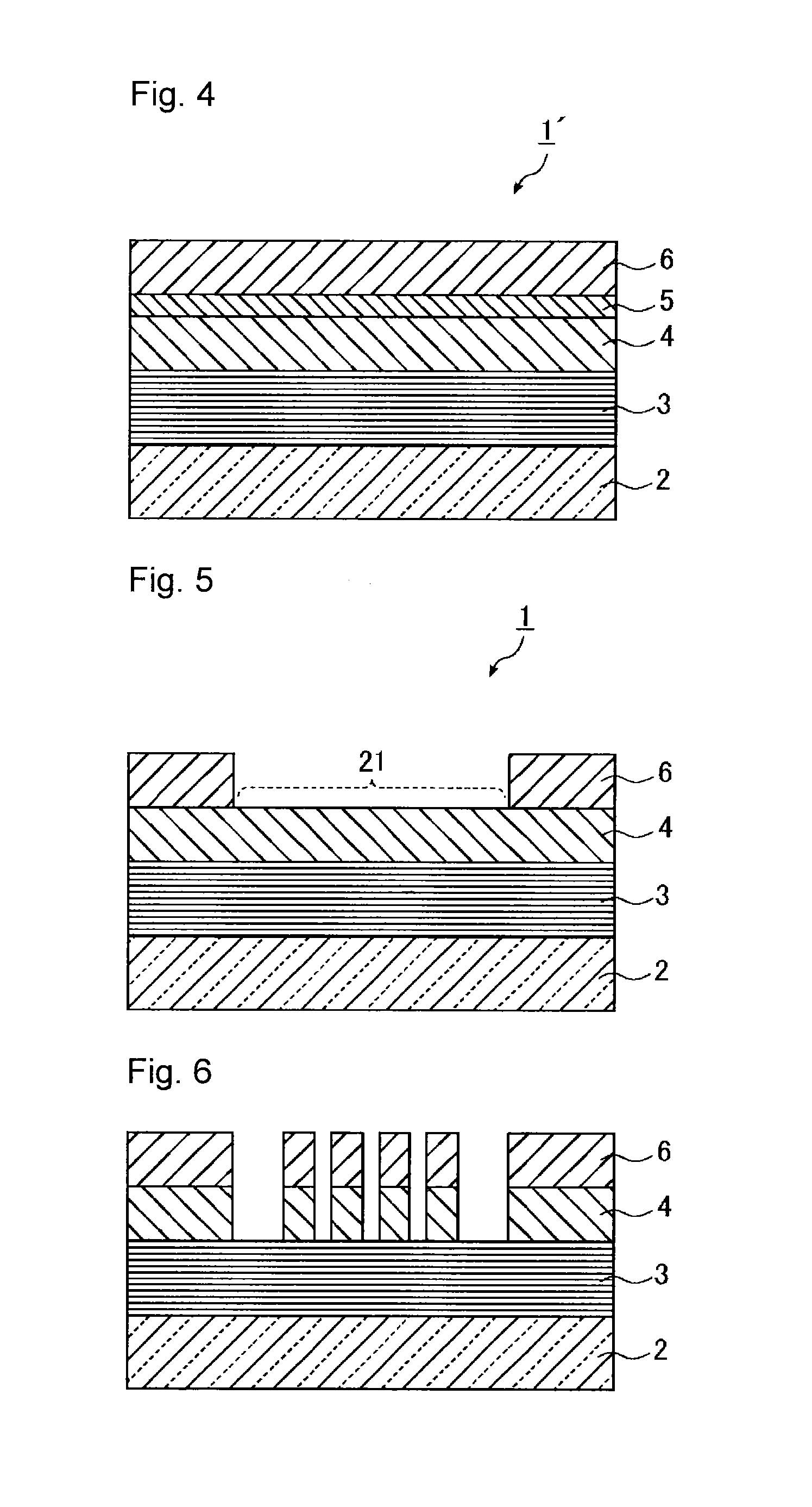Reflective mask blank for EUV lithography and reflective mask for EUV lithography
a technology of reflective mask and euv light, which is applied in the field of reflective mask for euv light, can solve the problems of not being able to use a conventional dioptric system like photolithography employing visible light or ultraviolet light, and the conventional photolithography method has come close to its limit, so as to reduce the thickness of the absorber layer, reduce the exposure of resist formed, and reduce the effect of reflected ligh
- Summary
- Abstract
- Description
- Claims
- Application Information
AI Technical Summary
Benefits of technology
Problems solved by technology
Method used
Image
Examples
example 1
[0269]In this Example, an EUV mask blank 1 shown in FIG. 3 is produced to determine whether the desired optical characteristics are satisfied in “the region outside the mask pattern region”.
[0270]As a substrate 2 for film-deposition, a SiO2—TiO2 type glass substrate (external shape is about 6 inch (about 152 mm) square, and the thickness is about 6.3 mm) is employed. The glass substrate has a thermal expansion coefficient of 0.05×10−7 / ° C., a Young's modulus of 67 GPa, a Poisson's ratio of 0.17 and a specific rigidity of 3.07×107 m2 / s2. The glass substrate is polished to have a smooth surface having a surface roughness (rms) of at most 0.15 nm and a flatness of at most 100 nm.
[0271]On the rear surface of the substrate 2, a Cr film having a thickness of 100 nm is deposited by using a magnetron sputtering method to provide a dielectric coating having a sheet resistance of 100Ω / □.
[0272]On a common electrostatic chuck having a flat plate shape, the substrate 2 (external shape: 6 inch (1...
example 2
[0308]This Example is the same as Example 1 except that as the light shielding layer 6, a CrON film is formed.
Film-Deposition Conditions of Light Shielding Layer 6 (CrON Film)
[0309]Target: Cr target
[0310]Sputtering gas: mixed gas of Ar, N2 and O2 (Ar: 49.4 vol %, N2: 13.8 vol %, O2: 36.8 vol %, gas pressure: 0.12 Pa)
[0311]Input power: 1,500 W
[0312]Deposition speed: 3.0 nm / min
[0313]Film thickness: 25 nm
Film Composition of Light Shielding Layer 6 (CrON Film)
[0314]The composition of the light shielding layer 6 was measured in the same manner as in Example 1, and the result is Cr:O:N=20:70:10.
Evaluation OF Reflectivity of Light Shielding Layer 6 for EUV Light and DUV-Vis Light
[0315]In the same manner as in Example 1, the surface of the mask blank 1 obtained by the above procedure was irradiated with EUV light (wavelength: 13.3 to 13.7 nm) and DUV-Vis light (190 to 500 nm), and the average EUV reflectivity and DUV-Vis reflectivity from the surface of the light shielding layer 6 were meas...
example 3
[0318]This Example is the same as Example 1 except that as the light shielding layer 6, a CrO film having a different content ratio of Cr and O is formed.
Film-Deposition Conditions of Light Shielding Layer 6 (CrO Film)
[0319]Target: Cr target
[0320]Sputtering gas: mixed gas of Ar and O2 (Ar: 40 vol %, N2: 60 vol %, gas pressure: 0.12 Pa)
[0321]Input power: 1,500 W
[0322]Deposition speed: 2.7 nm / min
[0323]Film thickness: 25 nm
Film Composition of Light Shielding Layer 6 (CrO Film)
[0324]The composition of the light shielding layer 6 was measured in the same manner as in Example 1, and the result is Cr:O=20:80.
Evaluation of Reflectivity of Light Shielding Layer 6 for EUV Light and DUV-Vis Light
[0325]In the same manner as in Example 1, the surface of the mask blank1 obtained by the above procedure is irradiated with EUV light (wavelength: 13.3 to 13.7 nm) and DUV-Vis light (190 to 500 nm), and the average EUV reflectivity and DUV-Vis reflectivity from the surface of the light shielding layer ...
PUM
 Login to View More
Login to View More Abstract
Description
Claims
Application Information
 Login to View More
Login to View More - R&D
- Intellectual Property
- Life Sciences
- Materials
- Tech Scout
- Unparalleled Data Quality
- Higher Quality Content
- 60% Fewer Hallucinations
Browse by: Latest US Patents, China's latest patents, Technical Efficacy Thesaurus, Application Domain, Technology Topic, Popular Technical Reports.
© 2025 PatSnap. All rights reserved.Legal|Privacy policy|Modern Slavery Act Transparency Statement|Sitemap|About US| Contact US: help@patsnap.com



